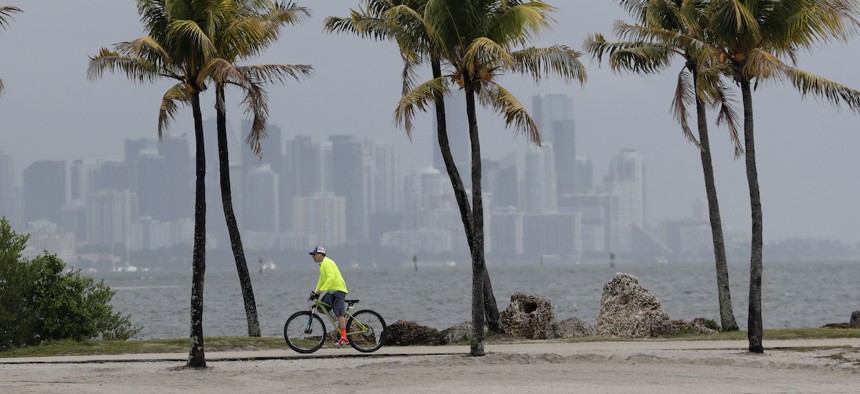NOAA Predicts Active Hurricane Season

The Miami skyline is shrouded in clouds that would become Tropical Cyclone Arthur as a cyclist rides along Biscayne Bay at Matheson Hammock Park, Friday, May 15, 2020, in Miami. Associated Press
The federal agency's annual forecast projects a likelihood of at least 13 named storms and six hurricanes.
Federal forecasters on Thursday predicted an above-average hurricane season, adding to the challenges facing state and local officials as they work to respond to the ongoing coronavirus pandemic.
The 2020 hurricane season outlook, released by the National Oceanic and Atmospheric Administration, predicts between 13 and 19 named storms, six to 10 of which could become hurricanes, with winds of 74 miles per hour or higher. Three to six of those are likely to be major hurricanes of Category 3 intensity (winds of 111 miles per hour) or higher.
An average hurricane season produces 12 named storms with six hurricanes, including three major hurricanes, the agency said.
A handful of climate factors contribute to the likelihood of a busy hurricane season, including warmer-than-average surface temperatures in the tropical Atlantic Ocean and the Caribbean Sea, an above-average West African monsoon season and the lack of El Niño conditions that typically suppress hurricane activity.
“Similar conditions have been producing more active seasons since the current high-activity era began in 1995,” the agency said.
For the sixth year in a row, the year's first named storm preceded the release of the annual hurricane season forecast. Arthur, a tropical cyclone, formed in the Atlantic late last week and passed near the North Carolina coast but never made landfall.
The combination of a major storm making landfall and the Covid-19 pandemic has the potential to wreak havoc on preparedness efforts for both governments and residents, officials said. Storm shelters could be operating at limited capacity to enforce social distancing, for example, while emergency supplies could be difficult to come by as supply chains continue to be strained.
Officials in Midland, Michigan dealt with that reality this week, as floodwaters from the rising Tittabawasse River swamped the city of 40,000 and surrounding communities. At a shelter, cots and air mattresses were kept six feet apart, while people were required to wear masks and volunteers regularly wiped down beds, the Detroit Free Press reported.
“Social distancing and other CDC guidance to keep you safe from Covid-19 may impact the disaster preparedness plan, including what is in your go-kit, evacuation routes, shelters and more,” Carlos Castillo, acting deputy administrator of FEMA, said in a statement. “Natural disasters won’t wait, so I encourage you to keep Covid-19 in mind when revising or making your plan for you and your loved ones, and don’t forget your pets.”
Kate Elizabeth Queram is a staff correspondent at Route Fifty and is based in Washington, D.C.
NEXT STORY: To stem COVID, this small Indiana city decided to test all public-facing employees





